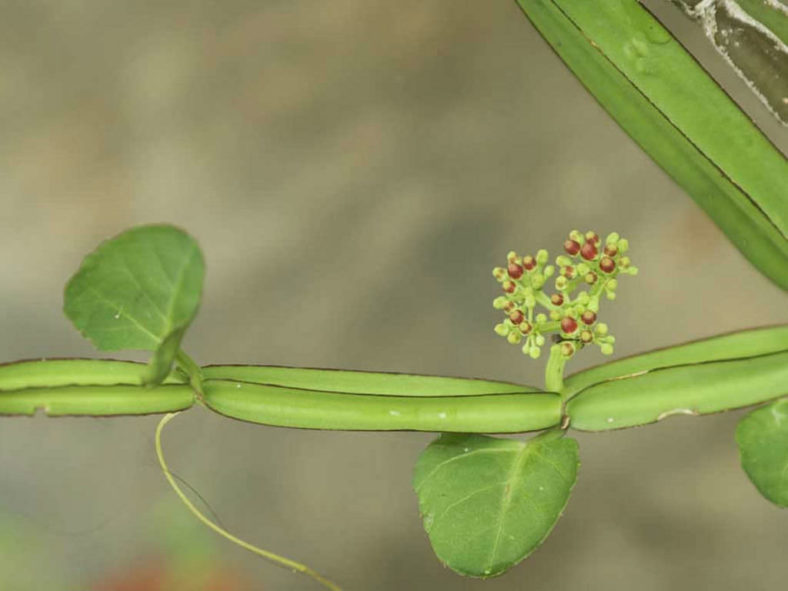Scientific Name
Cissus quadrangularis L.
Common Name(s)
Adamant Creeper, Devil's Backbone, Edible Stemmed Vine, Grape Leaf, Veldt Grape, Winged Treebine
Synonym(s)
Cissus quadrangularis var. quadrangularis, Saelanthus quadragonus, Vitis quadrangularis
Scientific Classification
Family: Vitaceae
Genus: Cissus
Description
Cissus quadrangularis is a sculptural climbing succulent with green, branched, quadrangular stems constricted at nodes and almost leafless when old. The fleshy stems are glabrous or slightly downy and can grow up to 5 feet (1.5 m) long. The leaves are variable in shape, smooth on both sides and measure up to 2 inches (5 cm) long and 1.2 inches (3 cm) wide. The tendril grows in the opposite direction of the leaf on the same node.
Mature plants produce racemes of tiny yellowish-green flowers followed by one-seeded fruits that are red when ripe. The fruits are spherical and up to 0.4 inches (1 cm) in diameter.
Origin
This species is probably native to drier parts of tropical Africa and Madagascar, Arabia, India, Sri Lanka, Malaysia, and the Philippines.

Hardiness
USDA hardiness zone 11a to 11b: from 40 °F (+4.4 °C) to 45 °F (+7.2 °C).
How to Grow and Care
Cissus quadrangularis is fast-growing and easy to grow. While most people who grow this plant are drawn to the curious geometric shapes of its stems, established plants make attractive, low-maintenance house plants. It probably shows best with their stems cascading from hanging baskets or when trained to grow on a trellis or similar support.
This plant responds very well to basic guidelines on growing succulents. It benefits from being moved outdoors in summer to experience warmer temperatures and increased daylight. Cissus quadrangularis will thrive under warm temperatures, bright sunlight, evenly moist soils, and occasional fertilization.
Once it has reached its desired size, it can be maintained by pruning any unwanted growth. In addition, pruning will encourage the production of numerous side branches, giving this plant a fuller, more lush appearance.
Keep in mind that this plant produces tendrils that help it secure a foothold on the plants and stones it climbs over. If you do not want this plant to become firmly attached to the plants or other objects in its growing space – keep it set apart from them.
It is easy to propagate additional plants by rooting cuttings. There is no minimum size for a cutting to root. A stem section with several segments is probably best, but this plant can be propagated from a single segment.
Links
- Back to genus Cissus
- Succupedia: Browse succulents by Scientific Name, Common Name, Genus, Family, USDA Hardiness Zone, Origin, or cacti by Genus
Photo Gallery
Click on a photo to see a larger version.



